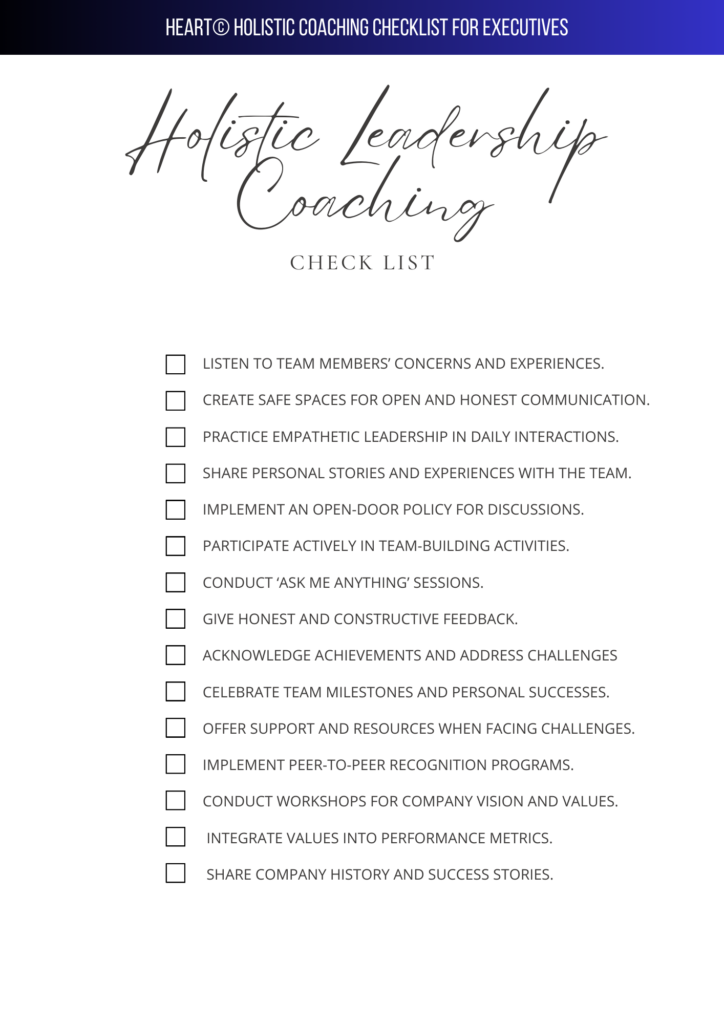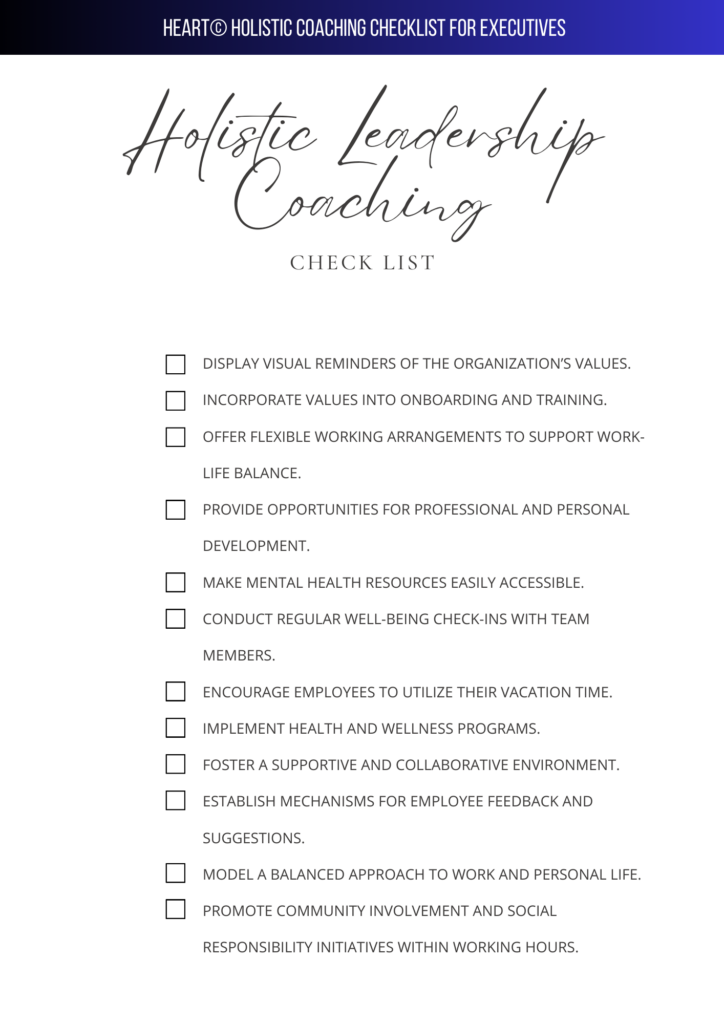In today’s fast-paced corporate world, it’s not uncommon for executives to feel a sense of disconnection from their organizations. As we navigate through these challenging times, it’s crucial to remember the importance of rekindling that lost connection. Today we will shed light on the HEART© Coaching method – a holistic approach to bringing life back to your organization and team.
Humanity and Empathy at the Forefront
The essence of HEART© Coaching is rooted in humanity and empathy. It’s about recognizing each team member as an individual with their own stories and aspirations. Emphasize listening and creating safe spaces for open communication. This not only helps bridge gaps created by digital communication but also fosters a deeper sense of understanding and connection within the team.
Engage with Authenticity
Authentic engagement involves more than just being present in meetings or sending out company-wide emails. It’s about genuine interactions where you, as a leader, share your own experiences and challenges. Authenticity breeds trust and respect. It humanizes you in the eyes of your team, fostering a more connected and open work environment.
Here are some ideas of how executives can engage with authenticity to foster a more connected and transparent work environment:
- Share Personal Stories and Experiences: Open up about your own career journey, including both successes and setbacks. For instance, discuss a time when you faced a difficult decision or a project that didn’t go as planned, and what you learned from it. This shows vulnerability and relatability, encouraging others to share their experiences.
- Regular ‘Open Door’ Sessions: Schedule times when team members can come and talk to you about anything, work-related or not. This could be a weekly or monthly open-door policy where you are available to listen and engage with employees without the formalities of a scheduled meeting.
- Participate in Team Activities: Join in on team-building activities or informal gatherings. For example, participate in a group volunteer day or attend a casual team lunch. Being part of these activities as one among the team, rather than as a superior, can break down barriers.
- Host ‘Ask Me Anything’ Meetings: Organize regular sessions where employees can ask you questions about any topic, from company strategies to personal career advice. This transparency can build trust and open lines of communication.
- Share Your Vision and Passion: Talk about what drives you, your vision for the company, and why you believe in what you’re doing. When employees see your genuine passion, it can be contagious and motivating.
- Provide Honest Feedback: During reviews or one-on-ones, give honest, constructive feedback. Acknowledge your own learning process in giving and receiving feedback, which can create a culture of continuous improvement and openness.
- Engage on a Personal Level: Take time to learn about your team members’ interests, families, and backgrounds. Remembering and acknowledging these personal details during conversations can show that you value them as individuals.
- Lead by Example in Difficult Times: During challenging periods, such as an economic downturn or a crisis, be upfront about the situation. Share your thoughts, concerns, and how you plan to navigate through it. Seeing leadership facing challenges head-on and transparently can be incredibly reassuring for the team.
- Encourage and Share Learning Experiences: Talk about a book, podcast, or seminar that influenced you recently, and encourage your team to share their learning experiences too. This fosters an environment of growth and continuous learning.
- Personalize Your Communication: Tailor your communication to be more personal and less formal when appropriate. For instance, sending a handwritten note to appreciate someone’s effort or a personalized email celebrating a milestone can make a significant impact.
Feel free to download and use our Holistic Leadership Checklist
Acknowledge Achievements and Address Challenges
A key aspect of building connections is to acknowledge both the successes and difficulties your team faces. Recognition goes a long way in making your team feel valued and connected. Celebrate the successes, no matter how small, and provide support and guidance through the challenges. This approach not only boosts morale but also encourages a culture of openness and honesty about both triumphs and trials.
Try some of the following to foster a supportive and connected workplace environment:
- Regular Recognition Meetings: Hold regular meetings or briefings where team members are recognized for their achievements, big or small. This could be anything from successfully completing a project to showing great teamwork, to going above and beyond in customer service.
- Personal Acknowledgment: Take the time to personally acknowledge individual accomplishments. This could be through a personal email, a mention in a team meeting, or even a simple thank-you note. Personalized recognition often holds more value than generic praise.
- Celebration of Milestones: Celebrate team milestones, such as the completion of a major project, anniversaries of employees, or reaching sales targets. These celebrations could range from a team lunch to a small office party or even public acknowledgment in company communications.
- Support in Challenges: When a team member is facing a challenge, offer support and assistance. This could involve providing additional resources, one-on-one mentoring, or simply a listening ear. It’s important to show that the organization cares and is willing to invest in helping employees overcome obstacles.
- Constructive Feedback: Provide constructive feedback in a way that is helpful and encouraging. Frame challenges as opportunities for growth and development, and offer clear, actionable advice on how to improve.
- Learning from Mistakes: When mistakes happen, use them as learning opportunities rather than just pointing out faults. Discuss what went wrong, what can be learned from the situation, and how similar issues can be avoided in the future.
- Peer-to-Peer Recognition Programs: Implement a peer recognition program where employees can acknowledge and appreciate each other’s contributions. This can help build a culture of mutual respect and appreciation.
- Showcasing Success Stories: Share success stories within the organization, through internal newsletters, bulletin boards, or company meetings. Highlighting these stories can inspire others and create a sense of collective achievement.
- Empathetic Approach to Challenges: When addressing challenges, do so with empathy and understanding. Acknowledge the effort put in, even if the outcome wasn’t as expected, and discuss how to move forward positively.
- Celebrating Personal Achievements: Recognize and celebrate personal achievements of team members, such as completing a degree or certification, running a marathon, or doing volunteer work. This shows that the company values its employees beyond just their professional contributions.
Revitalize Your Vision and Values
Often, disconnection stems from a loss of sight of the organization’s vision and values. Revisit these core aspects of your organization. Make them a part of everyday conversations. When your team understands and resonates with the ‘why’ behind their work, they feel more aligned and engaged. This alignment is critical in bringing back the vibrancy and dynamism to your organization.
Here you can find ways to actively incorporate the organization’s vision and values into various aspects of daily operations:
- Regular Vision and Values Workshops: Organize workshops or team-building sessions focused on the organization’s vision and values. Use these sessions to discuss what these principles mean to each team member and how they can be integrated into daily work.
- Incorporate Values into Performance Metrics: Align performance evaluations with the organization’s values. For example, if teamwork is a core value, include metrics that assess collaboration and support among team members.
- Storytelling of Company History: Share stories about the company’s origins, key milestones, and the vision that guided these achievements. This storytelling can be done through internal newsletters, team meetings, or special events.
- Leadership Role Modeling: Ensure that leadership consistently embodies and communicates the organization’s values. This could be through their decision-making, the way they handle challenges, and how they interact with the team.
- Visual Reminders: Use visual cues around the workplace, such as posters or screensavers, that highlight and remind employees of the company’s vision and values.
- Value-based Recognition Programs: Create recognition programs that specifically honor employees who demonstrate the company’s values in exceptional ways. This could include awards, shout-outs in meetings, or even feature stories in internal communications.
- Employee-led Initiatives: Encourage employees to lead initiatives or projects that align with the company’s values. For instance, if sustainability is a core value, employees could lead a green office initiative.
- Integrate Values in Onboarding: Ensure that new hires understand the company’s vision and values from the start. Include this in the onboarding process with training sessions, discussions, and materials that highlight these aspects.
- Value-themed Meetings: Start meetings with a quick discussion or reminder of one of the company’s values and how it relates to the agenda or projects at hand.
Customer and Client Feedback: Share feedback from customers and clients that aligns with the company’s vision and values. This demonstrates the real-world impact of these principles.
Feel free to download and use our Holistic Leadership Checklist
Embrace Holistic Leadership
Holistic leadership is about considering the well-being of your team in every decision you make. It involves balancing professional goals with personal growth and well-being. Encourage a culture where mental health, work-life balance, and personal development are prioritized. This approach not only improves the overall health of your organization but also fosters a sense of belonging and care.
These practices have helped many companies and leaders to create a more holistic, supportive, and caring work environment that values and nurtures both the professional and personal well-being of their team members:
- Implement Flexible Working Arrangements: Offer flexible work hours or the option to work from home to help employees manage their personal and professional responsibilities more effectively. This can improve work-life balance and reduce stress.
- Professional Development Opportunities: Provide opportunities for employees to grow their skills and careers. This could include training sessions, workshops, mentorship programs, or support for further education.
- Mental Health Resources: Make mental health resources readily available. This could involve offering access to counseling services, hosting mental health awareness workshops, or providing subscriptions to meditation and wellness apps.
- Regular Check-ins: Have regular one-on-one meetings with team members to discuss not just work progress but also how they are feeling and coping with their workload. Show genuine interest in their well-being.
- Encourage Time Off: Promote a culture where taking vacation time is encouraged, not frowned upon. Ensure that employees feel comfortable taking time off to recharge without feeling guilty or worried about work.
- Health and Wellness Programs: Implement health and wellness programs, such as fitness challenges, yoga classes, or health screenings. These initiatives show that the organization cares about the physical health of its employees.
- Create a Supportive Team Environment: Foster a team culture where support and collaboration are emphasized. Encourage team members to support each other, both in professional tasks and in achieving a healthy work-life balance.
- Employee Feedback Mechanisms: Have systems in place for employees to provide feedback on their work environment, management, and overall job satisfaction. Use this feedback to make improvements.
- Lead by Example: Demonstrate work-life balance and mental health awareness in your own life. Leaders who practice what they preach inspire their teams to follow suit.
- Community Involvement and Social Responsibility: Encourage and facilitate team involvement in community service or social responsibility projects. This can provide a sense of purpose and fulfillment beyond the daily work tasks.
Bringing Positive Change into the Workplace and Your Life
Remember, the journey to reconnection is continuous and evolving. It’s not just about implementing strategies but about embodying the values of HEART© Coaching in your everyday actions and interactions. The path to holistic corporate transformation begins with you. Be the change you wish to see in your organization.
Use our HEART© Holistic Coaching Checklist for Executives to keep up with the ongoing challenges in the workplace:
- Regularly listen to team members’ concerns and experiences.
- Create safe spaces for open and honest communication.
- Practice empathetic leadership in daily interactions.
- Share personal stories and experiences with the team.
- Implement an open-door policy for informal discussions.
- Participate actively in team-building activities.
- Conduct ‘Ask Me Anything’ sessions for transparent communication.
- Give honest and constructive feedback.
- Recognize individual and team achievements regularly.
- Celebrate team milestones and personal successes.
- Offer support and resources for team members facing challenges.
- Use mistakes as learning opportunities, not just faults.
- Implement peer-to-peer recognition programs.
- Conduct workshops focusing on the company’s vision and values.
- Integrate values into performance metrics and evaluations.
- Share company history and success stories regularly.
- Display visual reminders of the organization’s values.
- Incorporate values into onboarding and training processes.
- Offer flexible working arrangements to support work-life balance.
- Provide opportunities for professional and personal development.
- Make mental health resources easily accessible.
- Conduct regular well-being check-ins with team members.
- Encourage employees to utilize their vacation time fully.
- Implement health and wellness programs.
- Foster a supportive and collaborative team environment.
- Establish mechanisms for employee feedback and suggestions.
- Model a balanced approach to work and personal life.
- Promote community involvement and social responsibility initiatives.
Here are some invaluable nuggets on what HEART© Coaching is all about, how you position yourself for that holistic corporate transformation, and how to bring that positive change into the workplace and your life!
Watch or Listen at:
✨Youtube Video: https://lnkd.in/dzkp9A3N
✨Apple Audio Podcast: https://lnkd.in/gt-PygkY
✨Spotify Audio Podcast: https://lnkd.in/dpgDsKjf
Reconnecting with your team in these disconnected times might seem daunting, but with empathy, authenticity, acknowledgment, revitalization of core values, and holistic leadership, it’s more than achievable. Let’s embrace these principles and bring back the life, energy, and connection to our organizations and teams.
Stay connected, stay inspired.
Tassos Kotzias
Founder, HEART © Holistic Coaching Methodology
Linkedin | Facebook | Instagram | Website | Podcasts | Ebooks
Take the test and evaluate your workplace wellness level:
HEART© Coaching Checklist for Executives
1. Humanity and Empathy
- Regularly listen to team members’ concerns and experiences.
- Create safe spaces for open and honest communication.
- Practice empathetic leadership in daily interactions.
2. Engage with Authenticity
- Share personal stories and experiences with the team.
- Implement an open door policy for informal discussions.
- Participate actively in team-building activities.
- Conduct 'Ask Me Anything' sessions for transparent communication.
- Give honest and constructive feedback.
3. Acknowledge Achievements and Address Challenges
- Recognize individual and team achievements regularly.
- Celebrate team milestones and personal successes.
- Offer support and resources for team members facing challenges.
- Use mistakes as learning opportunities, not just faults.
- Implement peer-to-peer recognition programs.
4. Revitalize Vision and Values
- Conduct workshops focusing on the company’s vision and values.
- Integrate values into performance metrics and evaluations.
- Share company history and success stories regularly.
- Display visual reminders of the organization’s values.
- Incorporate values into onboarding and training processes.
5. Embrace Holistic Leadership
- Offer flexible working arrangements to support work-life balance.
- Provide opportunities for professional and personal development.
- Make mental health resources easily accessible.
- Conduct regular well-being check-ins with team members.
- Encourage employees to utilize their vacation time fully.
- Implement health and wellness programs.
- Foster a supportive and collaborative team environment.
- Establish mechanisms for employee feedback and suggestions.
- Model a balanced approach to work and personal life.
- Promote community involvement and social responsibility initiatives.



Recent Comments